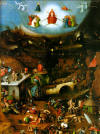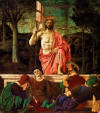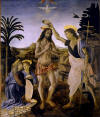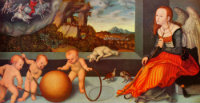Popular Questions About Renaissance Art
History
What is the difference
between Italian Renaissance art and Northern Renaissance art?
How did the Black
Death impact European art history?
How did the Inquisition
impact European art history?
What was the
influence of the Medici
Academy on Renaissance painters?
What was the
Bonfire of the Vanities?
Who were the greatest
painters of the Renaissance?
Search:: Artists Alphabetically Artists by Country Artists by Century Artists by Movement
Christ
Examples of Christ Depicted in ArtSigns and Symbols representing Christ in Western Painting
Gothic, Northern Renaissance and Early Renaissance paintings are rich in philosophical and Christian symbolism regarding Jesus Christ.
The Lamb - symbol of Christ as the Paschal Lamb, "Behold the Lamb of God, which taketh away the sin of the world!" (Bible, John 1:29).
Grape Vine, symbolizing Christians unification with Christ who said, "I am the vine; you are the branches."
Fish - one of the oldest and most important symbols of Christ
The Good Shepherd - images of Christ as the Good Shepard are mainly found in the catacombs.
IHS - the first three letters of the Greek name for Jesus.
Christ is central to Byzantine Art. According to the Holy Church "All the signs in the liturgical celebrations are related to Christ: as are sacred images of the holy Mother of God and of the saints as well. They truly signify Christ, who is glorified in them. They make manifest the "cloud of witnesses" who continue to participate in the salvation of the world and to whom we are united, above all in sacramental celebrations. Through their icons, it is man "in the image of God," finally transfigured "into his likeness," who is revealed to our faith. So too are the angels, who also are recapitulated in Christ"According to author Ernest Govett, "It is evident that the ideal Christ as established by the Italians can scarcely be improved upon in art within the prescribed limitations. Christ having lived as an actual man, His representation must be within the bounds of possible experience; and since He died at the age of thirty-three, intellectual power cannot be suggested in His countenance, for this in life means an expression implying large experience warranted only by mature age. The representation is therefore confined to that of a man who, while exhibiting a healthy regularity of form and feature, has lost all sense of earthly pleasure. The beauty achieved by this type is negative, the only marked quality being a suggestion of sadness which, in painting, is necessarily present in all expression where an unconcern with human instincts and passions is depicted. The Italians in their representation of Christ were thus unable to reach the height of the Greek divine portrayals. They were confined to earth, while[Pg 95] the Greek figures were symbols of spiritual forms which were pure products of the imagination. Giotto and his successors sought a physically perfect man with all purely human features in expression eliminated. The Greeks, even when representing divinities below Zeus, generalized all human attributes, excluding nothing but the exceptional. They embodied in their forms, truths acknowledged by the whole world; summed up human life to the contentment of all men: there was nothing in their divinities which would prevent their acceptance as spiritual symbols in all religions of civilized peoples. To them human instincts were sacred: all human passions could be ennobled: everything in the natural progression of life came within the purview, and under the protection, of the gods. So the course of their art was definite: there was never a difference as to the goal, for it was universal. "
Byzantine, Gothic Northern Renaissance and Renaissance Art are rich in philosophical and Christian symbolism.William H. Hunt once wrote "When language was not transcendental enough to complete the meaning of a revelation, symbols were relied upon for heavenly teaching, and familiar images, chosen from the known, were made to mirror the unknown spiritual truth." Narrative paintings, with their layer upon layers of readily understood symbolic meaning, provided instruction to the uneducated commoners that yearned for scriptural understanding. Paintings were used as guides that helped illuminate the divine mysteries of Church doctrine. Byzantine, Gothic and Renaissance Art are rich in philosophical and Christian symbolism. Narrative paintings, with their layer upon layers of readily understood symbolic meaning, provided instruction to the uneducated commoners that yearned for scriptural understanding. Paintings were used as guides that helped illuminate the divine mysteries of Church doctrine.
The Meaning of Sacred Symbols in Paintings. Most prominently featured symbols and their meaning:
The Four Evangelists
If you feel you have worthwhile information you would like to contribute we would love to hear from you. We collect essential biographical information and artist quotes from folks all over the globe and appreciate your participation. When submitting please, if possible, site the source and provide English translation. Email to millardmulch@gmail.com
☼☼☼☼☼
Key Words, People and Principal Phrases, Characteristics Related to the Northern Renaissance Art Movement - allegorical painting, rebirth, invention of oil painting, Hieronymus Bosch, Limbourg Brothers, Desiderius Erasmus, Robert Campin, Jan Van Eyck, Jean Fouquet, Albrecht Dürer, Johannes Gutenberg, Johann Reuchlin, Martin Luther, rise of the merchant class, world landscape, Low Countries, Protestant Reformation, Calvinisim, glazing, impasto, scriptorium, illuminator, invention of the printing press, woodcuts, engravings, Antwerp School, Guild of Saint Luke, commerce, Flemish School, Northern Europe, Antwerp School, Flanders, Bruges, renewed interest in classical learning, mythological scenes, genre painting, landscapes, portraits, moralizing overtones, human vices, lust, paradise, spirituality, piousness, living a simple life, reform, Human Reasoning, tradesmen at work, idyllic scenes of peasants, playing games, feasting, linear perspective, \Heliocentric Theory, humour, satire, spiritually significant, illuminated manuscript, idealized biblical themes, scriptorium, emotion, illuminator, iconoclast, Age of Discovery, Virgin and Child, axonometric drawing, curiosity about the natural world, realistic use of colours and light, Old Testament stories, Gospel parables, The Blackdeath, Christian symbolism
☼☼☼☼☼
Search for Artists by Century Important Painters Born in the 13th Century Important Painters Born in the 14th Century Important Painters Born in the 15th Century Important Painters Born in the 16th Century Important Painters Born in the 17th Century Important Painters Born in the 18th Century Important Painters Born in the 19th Century☼☼☼☼☼
Require more facts and information about The iconographical interpretation of Symbols in Byzantine, Gothic and Renaissance Painting? Poke around every nook and cranny of the known universe for information this subject. Search Here
© HistoryofPainters.com 2017
If you like this page and wish to share it, you are welcome to link to it, with our thanks.






